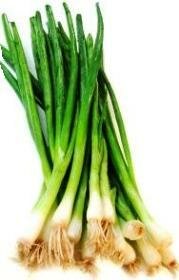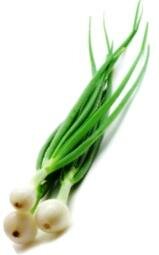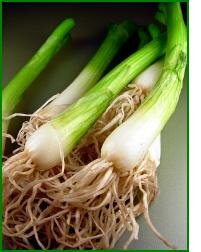Growing Spring Onions or Scallions
Here's how to grow scallions... or is it growing spring onions? What's the difference, if any, and what about growing Salad Onions, Green Onions and Bunching Onions?
Whatever you call these tasty white and green stalks, they are all similar and it's partly a case of different names in different countries. Although there is general disagreement on what's called what, most of them are cultivars of the original Welsh Onion (Allium fistulosum).
To un-muddle the muddle, read what the elves at the bottom of MY garden say...

Scallions
These are often called Salad Onions and in some countries such as Australia, New Zealand and India they are known as Spring Onions or even Shallots. It's probably because shallots have a mild flavour that they've been confused with scallions. See all about Growing Shallots here.

Scallions are really like thick chives. They have no curvy figure, starting off at the roots with a white base and then straight up with hollow green stalks. Scallions must be harvested when the stalks are still green and you eat the whole plant, except the roots.
With the mildest flavour of all the onions, scallions are usually eaten raw in sandwiches, salads or for toppings.
How to grow Scallions for propagating
There is never any hint of a bulb in a scallion so you can't leave the plants in the ground for the tops to dry off — they will, but you won't be able to save any bulbs.
Let some flower the following year and save the seed. Some scallion varieties are bunching and more or less perennial, dying down in winter and springing to life in spring. It's a good idea to divide these bunching scallions just before spring growth and replant with fresh compost and soil.
Spring Onions

When growing spring onions you'll see that they have slightly rounded bulbs that are more defined and larger than the slender scallion onions.
Spring onions are the most pungent tasting of young onions with a bit more bite than green onions. Remember, most onions gain their sharp taste as they mature.
Spring onions can be used raw or cooked. Because raw spring onions are pungent, taste to make sure their flavor does not overpower more delicate flavors.
Cooked spring onions—usually sautéed for a few minutes—will be more delicately flavored as a result of the cooking process and are a good combination with other spring and summer vegetables.
The spring onion is distinctly different than a green onion to many growers and onion lovers in the United States. In England and Australia, a spring onion and a green onion are most often considered the same.
How to grow Spring Onions for propagating
As with scallions there is not enough of a bulb to be able to save and store for planting the next season. True spring onions don't usually form bunches, so they aren't perennial. They are biennial, growing a flower and seeding the second year. So let a plant or two go to seed and use the seed for your next crop.
Green Onions or Bunching Onions

To onion lovers and growers here's where there is a difference. A green onion or bunching onion has gained the hint of a bulb with maturity; a scallion has no bulb and a spring onion has a small bulb.
Green onions have long, green, delicate stalks and small, very slender, white bulbs. The bulb of a green onion is slightly defined.
Green onions come out of the ground early in their lives... in fact you can sow them very early spring and usually pick them late spring 7 weeks later.
They are mild tasting having not been alive long enough to gain much pungency. Green onions can be used sliced or chopped raw in green salads or creamy salads like potato salad, pasta salads, or atop baked potatoes.
Green onions are sometimes called bunching onions. When onion seeds are planted densely they grow so close or bunched together that the bulbs have little chance of fully maturing and rounding completely out.
Green onions are green onions in the United States; in England and Australia the green onion is also called a spring onion. Green onions are sometimes also called scallions. (But, now, you know there is a difference even if ever so slight.)
Immature Ordinary Onions

Instead of growing real spring onions or scallions, many gardeners grow ordinary onions and pull them from the soil before their bulbs are developed.
Any of the onion varieties from red, yellow to white can be used this way, especially if you plant your onions thickly, then it's just a case of thinning some to eat as spring onions and even some later as small bulbs.
Another popular practice is to help yourself to a few of the green leaves on your onion plants but leave enough so that the onions grow on to maturity. You can safely thieve up to 1/3 of the green leaves, cutting down to the last 2.5cm (½") on each leaf.
Conditions for Growing Spring Onions, Scallions,
Green and Bunching Onions

(The whole bally lot are lumped together under one name, Spring Onions, from here on to make reading easier).
Information on growing spring onions is often overlooked by many gardening books. However, they are one of the easiest vegetables to grow in your garden and can be used in a variety of recipes, especially salads... hence another of their popular names of Salad Onions.
As with the rest of the members of the onion family, spring onions grow best in well-drained soil with a pH value ranging between 6.3 and 6.8. They are fast growing so give them good nutrition.
Clay soils must be rectified by mixing in adequate amounts of rotting compost or peat and sand to increase its friability and provide adequate moisture with good drainage.
Planting Spring Onions
When growing spring onions, they can just as easily be planted indoors in a pot as outdoors in a patch. The best time to plant them is the end of spring in May-June in northern hemisphere and November-December in southern hemisphere. Obviously it depends on your climate and situation; so many gardeners can plant earlier than this.
There are also some varieties that can be grown in winter in milder climates or in pots indoors or in a greenhouse over winter.
Drill holes that are about 1.5cm deep and place your seeds in them. Gently cover them with fine soil to a depth of roughly 1cm (¼-½"). Maintain a space of at least 5cm (2") between seeds. If you're growing spring onions in rows then the distance between each row shouldn't be less than 15cm (6"), otherwise scatter seeds in spare patches throughout your garden.
For a continuous supply, sow seeds every fortnight. You can buy small punnets of spring onion etc seedlings, but make sure you tease out the roots and plant each plant separately and well spaced to allow good growth.
Tending
Keep an eye on your seeds to ensure that they get enough water whenever you notice the soil is dry. However, be careful as you don't want to waterlog them. That can result in very large and weak spring onions.
Watch over them with an eagle eye for about 6-7 weeks. This is especially important because the seeds need time to establish themselves firmly in the soil by means of strong roots. Keep the patch weed free.
Because the likes of spring onions, scallions and green onions are fast growing, they tend not to be troubled by pests and diseases, but any worries can be found at: Pests and Diseases of Onions

Harvesting
Harvesting time can come by as early as two months after sowing seeds, but some need another 2-4 weeks. Spring onions are ready to eat when the leaves are standing tall, green and succulent.
You can use scissors to cut the leaves working from the outside to the inside (but not demolishing or using up the entire plant). These can be used as garnish or added to salads or stews for flavor. The earlier you harvest your spring onions the more delicate the taste you can enjoy.
If you want to harvest the entire bulb and leaves then make it a point to use a fork to dig around the plant to keep from damaging it inadvertently. Pick out each bulb from any bunches that might be a bunch of individual bulbs clumped together.
Spring Onions in the Kitchen

Spring onions can not only provide their own unique taste but can act as a substitute for onions if you have run out of stock. The advantage of growing spring onions in your garden means there's no worry about freshness. Any of the green onions bought in the market simply don't decently last more than a week if you don't make use of them.
Wouldn't it just be nice to go and pluck these from your backyard when you need them without having to worry about them going yellow and soft in your fridge?
Now you are an expert on growing spring onions, scallions, salad onions or green onions, check out more herbs to grow: Growing Herbs





